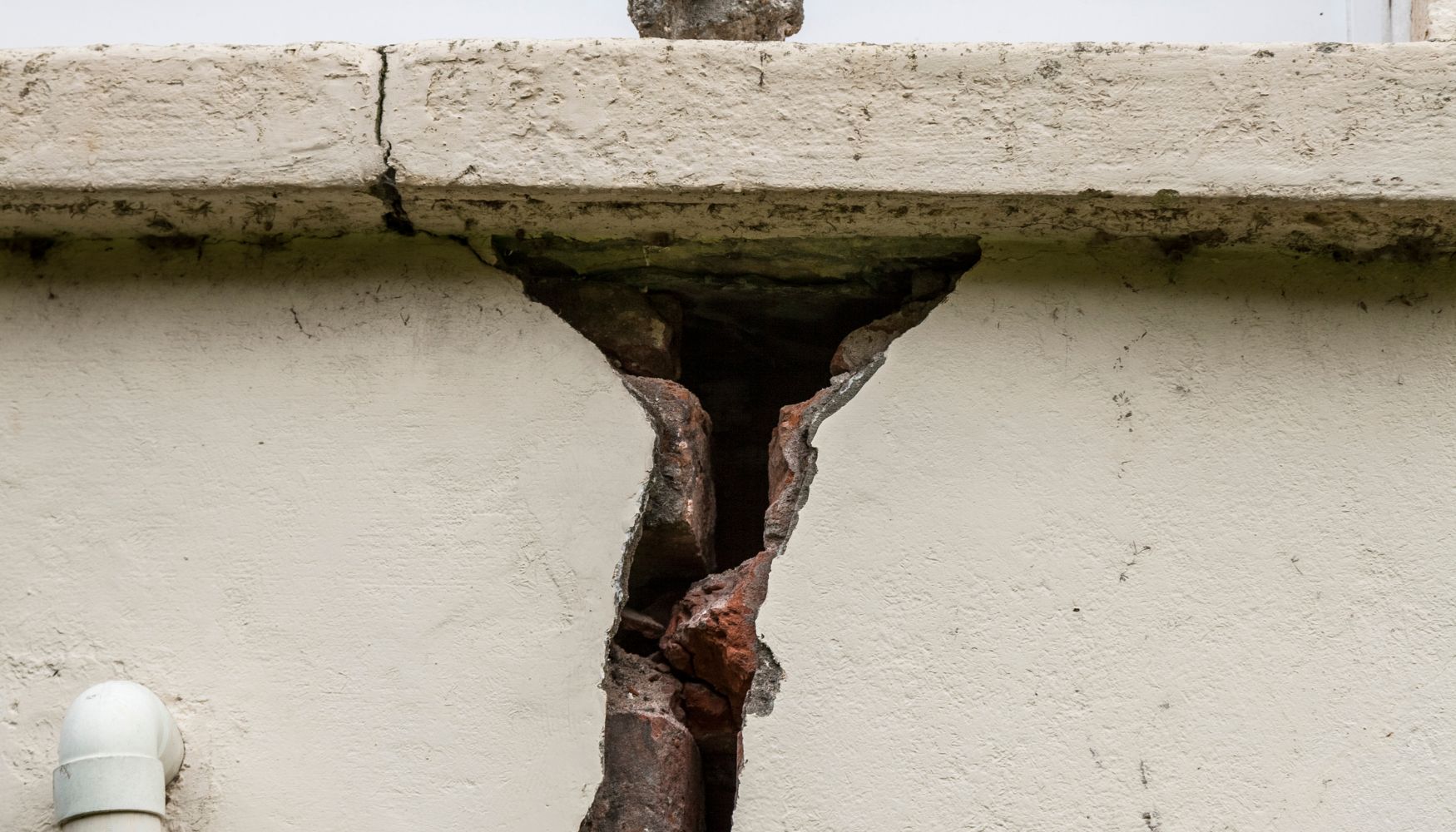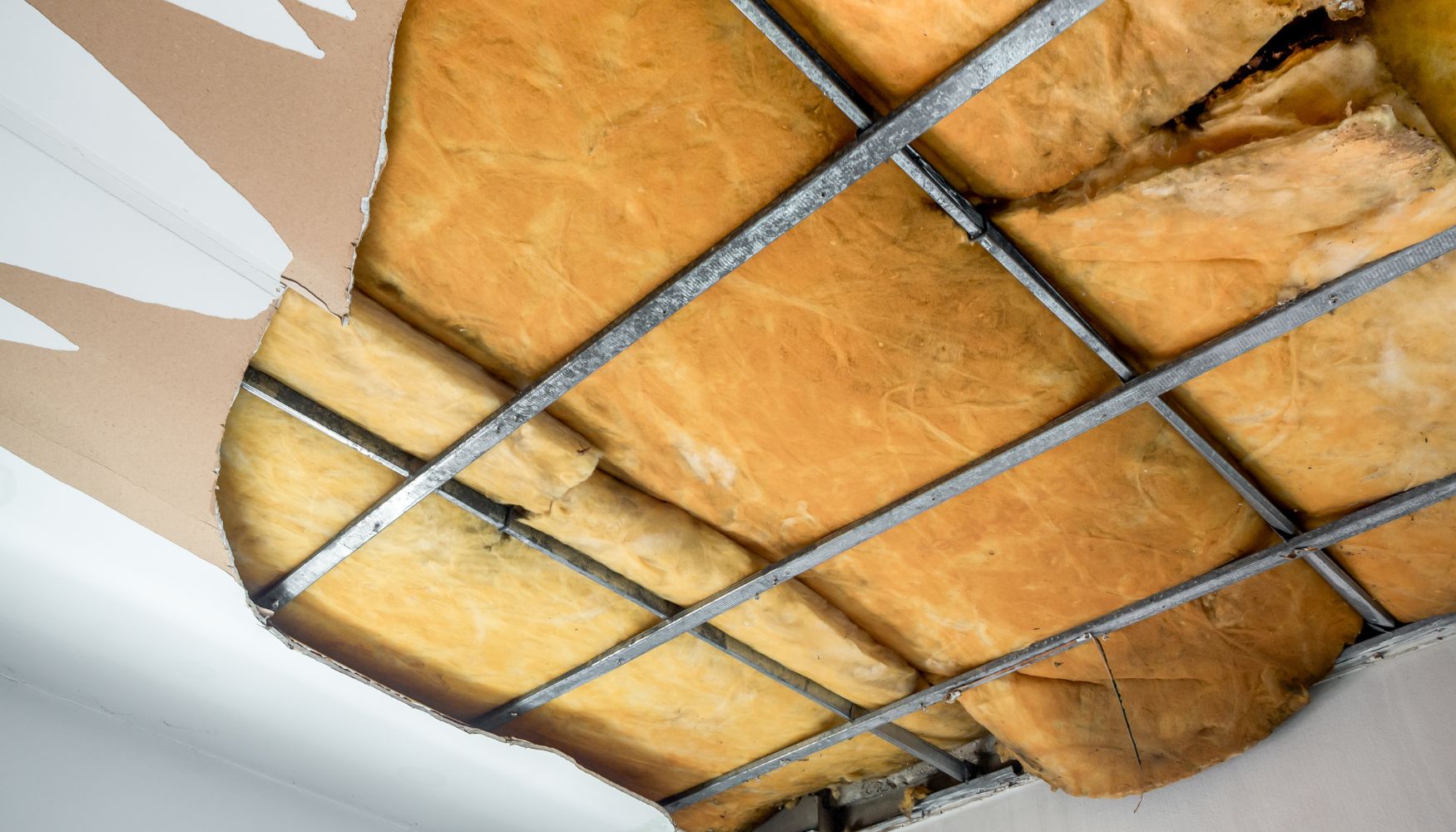That little crack in the wall over the window is back — the one you filled in last month and painted over. And now the window won’t open all the way without sticking. Something is going on.
When the structure of our house is damaged, a lot can go wrong. It’s important to be aware of the symptoms, which may indicate a deeper issue that can put the structure at risk.
We will show you how to identify signs of structural damage to your house, and how important it is to have a professional inspection done if you notice anything suspicious.
Table of Contents
- Recognizing Structural Damage
- Can Structural Damage to a House Be Fixed?
- How To Determine if There Is Structural Damage in Your Home
- Structural Damage Repair and Restoration Process
- Pure Environmental: Structural Damage Repair and Restoration Services for Your Home
Recognizing Structural Damage
Any damage affecting the stability and integrity of your home is considered structural. This can include damage to the:
- Roof
- Walls
- Foundation
- Chimney
The average person is often able to identify some of the common indicators of potential structural damage:
- Cracks are one of the most obvious indications of something wrong with the structure of your house. Small, thin cracks can be a natural part of seasonal shifts or a new home “settling” and shouldn’t cause too much concern. A wider crack — or one that grows over time — could point to instability or uneven sinking in the foundation.
- Bulges or bowing in the walls or floors may appear if part of your house is shifting or sinking. This can be especially noticeable at the door and window openings if they don’t open or close properly.
- Water or moisture in the wrong places could point to a problem with the roof or any of the various seals meant to weatherproof your home. If the unwelcome water is from a plumbing leak, it could cause structural damage over time if left unaddressed.
If you’re suspicious of structural damage to your house, hire a professional to determine the cause and if repairs are required.
Can Structural Damage to a House Be Fixed?
Many types of structural damage can be fully repaired if the damage is not too extensive. The underlying root cause must be properly assessed and addressed by someone with the right skills and experience.
Underlying Root Cause
The underlying root cause of the damage must be properly diagnosed and resolved. If repairs are done without addressing the root cause, the damage might simply reappear, wasting time and money.
It is easy for small problems to become big problems if they’re left unaddressed.
Even worse, an unresolved root cause may leave you in harm’s way. Imagine if a ceiling crack was repaired without addressing the fact a load-bearing beam was shifting and about to collapse.
Type and Extent of Damage
Often the decision of whether structural damage is repairable comes down to a question of cost of the repair vs. the value of the home after the repair is complete. There are some scenarios where this difficult decision needs to be made. For example:
- The damage might not be covered by insurance if a flood or earthquake caused it. This would leave the homeowner on the hook for a massive expense.
- If it is determined there are significant building code violations or other safety hazards, it could require so much reconstruction that it would be most cost-effective to completely rebuild.
- There may be so much damage from wear and tear that resolving all the issues would cost more than demolishing the house and rebuilding.
Who Does the Repairs
Resolving structural issues in your house is typically not DIY-friendly. Unskilled homeowners may end up addressing the visible problem without actually resolving the underlying root cause.
Trying to tackle an issue yourself can result in making the problem worse, and risks causing physical harm. It’s time to call a pro.
Pure Environmental can help you remediate any damage to your home and find any underlying structural issues that need to be repaired. Contact us today for a free estimate.
How To Determine if There Is Structural Damage in Your Home
Depending on the problem you are observing, it could point to an underlying structural issue or to a problem that could result in a structural issue if left unaddressed. The best way to know for sure if there is structural damage in the house is to get an inspection.
Cracked Windows, Ceilings, or Walls
When a home is built, some settling typically happens within the first year or two. This can result in hairline cracks that only need superficial repair. However, if a crack grows to more than a quarter of an inch wide, it could indicate uneven settling or other instability.
Cracked windows could indicate excessive pressure being caused by the shifting structure. If cracks develop in a basement window, it could have been caused by a problem with the foundation.

Sticking Doors or Windows
A shift in the wall can change the shape of the frames and cause doors and windows to stick. If a window or door that was once easy to open and close suddenly isn’t anymore, this could point to a more serious issue.
If the shift was caused by excessive movement in the foundation or some other instability in the house, resolve it before making repairs to the affected doors and windows.
Termite Damage
A termite infestation can be a nightmare, and will eventually cause severe structural damage to your house. Noticing the telltale signs of termites and acting quickly may spare you from needing a massive overhaul. Signs to look for include:
- Mud tubes are the tunnels built by termites for protection as they travel from place to place. They are usually an inch or less in diameter and look almost like “veins” running along the wall or ceiling. A common location for mud tubes is along the exterior of the foundation.
- Frass is the droppings of termites that collect in small piles, resembling sawdust. Termites will create a hole in their nest where they push out the waste, and frass tends to accumulate below these holes.
- Discarded wings are a sign of termites in the immediate area. As a colony matures, some termites grow wings and leave the nest to form a new colony. Eventually, these termites discard their wings.
- Wood that seems “hollow” to the touch or has visible damage may have been munched on by termites. Act quickly, as you have no idea how much more wood damage may be hidden from view.
- Uneven or bubbling paint can be caused by moisture migrating from behind, through termite-created holes. Also, if termites eat the wood directly below a layer of paint, it will affect the adhesion and appearance of the paint.
Cracks in the Foundation
Normal settling can cause small cracks in a house’s foundation, similar to what is often seen in walls and ceilings. If the cracks are small enough, and stay small, they can usually be ignored.
Cracks running horizontally can indicate pressure imbalances. Uneven soil settlement or poor drainage are common causes of pressure imbalances and can cause shifting and cracking, leaving your home vulnerable to serious damage.
A crack in any direction that gets wider or longer is cause for concern. Monitor cracks in the foundation. If things look worse a few months later, get a structural engineer to perform an inspection.
Uneven or Damp Floors
A very slight unevenness in a floor can be part of normal house settling, but it can also result from excessive moisture. The buildup of moisture can cause beams or subflooring to warp. The floor may even be damp to the touch.
There are several potential causes for moisture buildup, including a leaking pipe. Poor ventilation can also trap moisture due to the lack of air movement.
Unevenness in the foundation floor can be caused by poor soil drainage or the pooling of groundwater. If left unaddressed, this could further result in the shifting of foundation walls and turn into a larger structural issue.
Crumbling Concrete or Bricks
Prolonged contact with high moisture can weaken bricks and concrete and cause them to deteriorate. This may result in not only cracks but actual crumbling of the material as well.
Proper drainage of rainwater off your roof and away from your house is an important part of minimizing water damage. Ensure roof gutters are intact and clean, and downspouts direct water away from the foundation.
If there are cracks that continue through the mortar and the bricks themselves, this may indicate excessive structural shifting and should be investigated by a professional.

Sagging or Leaking Roof
Your roof shouldn’t be sagging, and definitely shouldn’t be leaking. If any roof lines look uneven, there may be some shifting or deterioration of the roof or the framing.
If there has been a shift in the roof’s shape, it may be due to movement originating further down in your house. A proper inspection should examine your entire house — top to bottom — to find the root cause of the movement and the best way to stabilize it.
Pillowing of the Ceiling
If you notice a “pillowing” effect or any other sagging, warping, or excessive cracking in your ceiling, it needs immediate attention. Failure to do so could eventually result in the ceiling collapsing and seriously injuring someone. Here are a few issues that could be at play:
- Water damage: If there is a leak in the roof or in an overhead pipe, water could pool on top of the ceiling, causing it to sag or bulge.
- Termites: If there is termite damage to the beams or joists, the ceiling may not have the structural support it needs.
- Structural shifting: This may be due to the home’s natural seasonal expansion/movement, or a stability issue. An inspector can determine if it’s serious enough to need repairs.
- Age: Your home may simply be feeling the effects of age — the natural failure of adhesives, fasteners, drywall, or plaster. Luckily, these repairs are often much less trouble than addressing structural stability.

Exposed Gaps in Walls
If gaps form between walls, it could point to sagging floor joists. Excessive settling of the foundation can cause floor joists to sag. Also, if there is termite damage to the supporting timber, it can cause floor joists to sag.
The sagging floor joists could also be due to poor construction. If support pillars are too far apart, or if there is otherwise not enough support for the floor joists, sagging can occur.
Structural Damage Repair and Restoration Process
If you see damage or irregularities that could be related to a structural issue, it’s important to get an inspection as soon as possible.
The experienced team at Pure Environmental will walk you through each step in the repair and restoration process, including:
- Surveying the damage and investigating the root cause
- Providing you with a list of necessary repairs to restore structural integrity
- Working with your insurance company on your behalf to ensure the best outcome for your claim
Pure Environmental: Structural Damage Repair and Restoration Services for Your Home
Sometimes, the cosmetic issues you notice around your home are the symptoms of something much more serious.
With the potential for structural damage in your house to get worse over time and cause major problems, it’s important not to play guessing games.
Pure Environmental is here for any home repair needs you may have, and can ensure structural issues are dealt with properly.
Trust Pure Environmental to restore your house, and make your structure safe and sound.
Recent posts
- Pros and Cons of Heat Treatment for Bed Bugs: Things To Consider When Reviewing Your Options for Remediation
- How To Get Rid of Pet Odor in Your House
- Clearing the Air: How To Clean Walls From Cigarette Smoke
- Deodorizing Your Living Space: How To Get Rid of a Musty Smell in Your House
- How Do You Get Rid of Mold in Your Attic? Tips from the Professionals
Recent Posts
- Pros and Cons of Heat Treatment for Bed Bugs: Things To Consider When Reviewing Your Options for Remediation
- How To Get Rid of Pet Odor in Your House
- Clearing the Air: How To Clean Walls From Cigarette Smoke
- Deodorizing Your Living Space: How To Get Rid of a Musty Smell in Your House
- How Do You Get Rid of Mold in Your Attic? Tips from the Professionals
